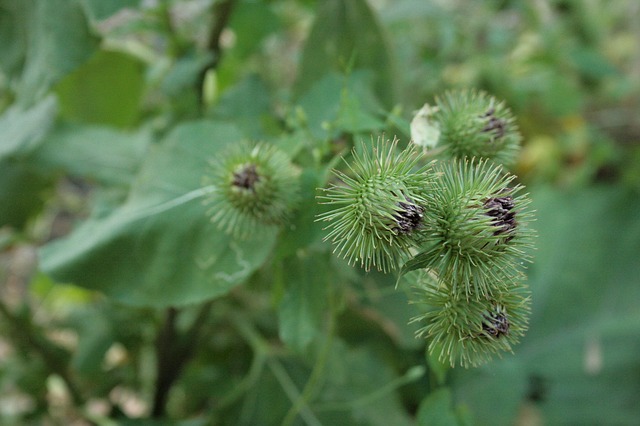Not recommended for use
It is often believed that burdock should not be used by pregnant and lactating women, which is fundamentally wrong. The large burdock is one of the rare plants that does not cause side effects. This belief is due to the fact that large burdock is rarely found alone, but is used in various mixtures with other plants that also cause side effects. Of course, if you do not feel safe about the use of this plant, you can inquire about it with the attending physician.
Medicinal Recipes
Decoction of burdock roots: 10 grams of the drug is placed in an enameled container and poured with 200 ml of hot, pre-boiled water. Close the cap and put in a water bath, stirring often for about 30 minutes, cool at room temperature for 10 minutes, squeeze out the thickets. The obtained decoction is supplemented with boiled water up to 200 ml. The resulting decoction is stored in a cool place for no longer than 2 days. Use ½ cup warm, 2-3 times a day.
Preparation of the root of the great thistle: pour 10-25 grams of the crushed drug with 400 ml of boiling water, keep it in a thermos for 1 hour, then separate the thick parts. Take ½ cup warm, 3-4 times a day after meals.
Ointment from large burdock: 40g of fresh roots are placed in 100ml of vegetable oil for 24 hours, then boiled on low heat for 15 minutes. The second version - 50 grams of fresh root is grated and mixed with 50 grams of pork fat. The third version - boil 25 grams of leaves and 25 grams of roots in 100 ml of water for 20 minutes. After that, the thickness is grated and mixed with 100 grams of butter.
Big thistle oil: the crushed roots are placed in almond or olive oil for a couple of days. If used for hair, you can also add hot pepper.
Steeping the leaves of the big burdock: pour 60g of the drug with 600ml of boiling water, let it steep for 4 hours, then separate the layers. Use 1 glass, 3 times a day.
Big burdock leaf juice: squeezed from freshly harvested, young leaves. Use together with honey (10:1), 1/3-1/2 glass before meals.
Decoction of burdock leaves and inflorescences: boil 20 grams of the drug in 200 ml of water for 5 minutes. It is used for compresses and baths.
Planting of burdock seeds: pour 20g of the seed with 200ml of boiling water, let it set, then separate the thickets. Use 25-50ml, 3-4 times a day.
Big burdock roots extract in water: 1 teaspoon of crushed roots, pour 0.5L of boiling water, leave overnight. Use hot, drink during the day. Used for bladder stones and kidney stones, gastritis and stomach ulcers.
Burdock root improves hair growth. A decoction of the roots is prepared for this, which is used long-term, every day, wetting the scalp with it. Fill 1/3 of a small pot with burdock root and cover with water, almost to the edge of the pot, cook on a low flame for 30-40 minutes, separate the thickets. Such a decoction can be stored in the refrigerator for no longer than 5 days. Use as needed, warm up a little before use.
Solution for internal use: pour 2 tablespoons of burdock roots with 500 ml of boiling water - a daily dose.
Burdock preparations are good cleansers with antioxidant properties. Root decoction removes not only excess salts, slags and toxins from the body, but also substances such as mercury compounds. Pour 10g of dried crushed root with one glass of hot water, boil for 15-20 minutes, separate the thickets, add the decoction to the original volume. Use 1 tablespoon, 3-4 times a day.
In case of sharp pain in the stomach, a decoction of the plant or its juice is used: 1 tablespoon per 1/3 cup of warm water.
In case of constipation, a decoction of burdock seeds helps: pour a handful of ripe seeds with 1 cup of boiling water, boil for 2 hours, separate the pulp and drink in one go.
In case of cholecystitis, gallstones, chronic pancreatitis, drink a decoction of the roots: 20 grams of dry crushed drug per 1 glass of water, boil for 30 minutes, let it rest for 20 minutes, separate the thickness, add to the original volume. Take 1-2 glasses 3 times a day before meals.
To reduce fever: 4 tablespoons of dried burdock root in 4 cups of water, boil until the volume of water is reduced by half, separate the thickets. Add 2-3 tablespoons of honey to the decoction. Use 1 glass, 3 times a day after meals.
Rinsing agent, in case of stomatitis: 1 tablespoon of dried burdock root per 1 glass of water, boil for 15 minutes, let stand for 1 hour, separate the layers, add to the original volume.
In case of dislocations and sprains, compresses are made from burdock and placed directly on the painful area, you can also apply fresh burdock root mixed with vegetable oil - which will help even in case of severe bruises and hematomas.
With the large burdock, you can get rid of skin warts perfectly, if you mix its juice with table vinegar and drip it 1-2 drops a day on the wart.
In the case of urinary tract stones, make a decoction: 20 grams of dried roots, pour 1 glass of hot water, boil for 10 minutes and leave for 2 hours, then separate the thickness. Drink ½ glass, 3 times a day.
In case of gout, a local application is made from dry or fresh leaves. They are washed off and placed locally on the painful area in a thickness of 5-6 sheets, covered with compress paper and covered with cloth.
In case of diabetes, a decoction of burdock root is used, 1 tablespoon, 3-4 times a day: pour 10 grams of dried drug with a glass of water, boil for 15-20 minutes, let it rest for 30 minutes, separate the thickness, add to the original volume.
To treat rickets, a root decoction is used, warm for 2 tablespoons, 2-3 times a day before meals. (1 tablespoon per 1 glass of water, boil for 30 minutes, cool for 10 minutes, separate the layers and restore the volume).
Importance of food
Burdock roots can be used fresh as an ingredient in salads. It should be noted that the fluffy burdock is significantly more bitter than its other brothers. Most often, the large burdock is cultivated, because its parts are the most pleasant in taste.
Burdock roots (first year), leaves and stems are boiled, stewed, fried, like any other vegetable. However, you should know that any burdock will give a little bitterness. Of course, the leaves and stems are also harvested young.
The dried root can be ground and added to the flour used to bake bread. Likewise, the root can also be roasted to obtain a powder similar to chicory, which can be used as a coffee drink.
The leaves can be boiled or used in dishes, like a spinach-like plant. However, the leaves are very fluffy and this spoils the whole pleasure of eating them, so it is best to use them in dishes where the leaves have to be chopped. Their stems are tastier than the leaves, they are much meatier and juicier. It is recommended to peel the base of the leaf stems, then you can add them to soups, salads, stews and anything else you can imagine.
Diet recipes
Salad from large burdock
150 gr. big burdock roots, 30 gr. horseradish, 50 gr. rim, 20 gr. cream, salt.
Wash and rinse the leaves in boiling water for 1-2 minutes. Dry and grind. Mix with chopped onion, salt, add horseradish and cream.
Big burdock leaf soup
300 gr. large burdock leaves, 80 gr. onion, 40 gr. rice, 40 gr. fat, 200 gr. potato, salt and pepper as desired.
Cleaned, cut potatoes and rice are boiled. Chopped burdock leaves and pan-fried onions are added to the soup 15 minutes before serving.
Burdock puree
1 kg of burdock leaves, 100 gr. sorrel, 100 gr. salt, 25 gr. dill, pepper as desired.
Grind burdock leaves with a meat grinder, add salt, pepper, dill, sorrel and mix. Place in a 3L jar and store in the refrigerator. It is used as an additive to soups, salads and as a seasoning for meat and fish dishes.
Roasted burdock roots
Washed burdock roots are cut into rounds, frozen and baked in the oven or on the fire.
Fried big burdock roots
500 gr. burdock roots, 50 gr. vegetable oils.
Boil burdock roots in salted water. Then fry on a pan.
Big burdock povidla
1 kg of burdock roots, 1 L of water, 50 gr. essences of vinegar.
Add vinegar to the water and boil. Burdock roots chopped in a meat grinder are added to the boiling mixture and boiled for ~2 hours. Povidla can be used with tea or with other sweet dishes.
Big burdock coffee
The roots are dried and roasted in the oven until they turn brown. Grind in a coffee grinder and use 1-2 teaspoons per cup of boiling water.









